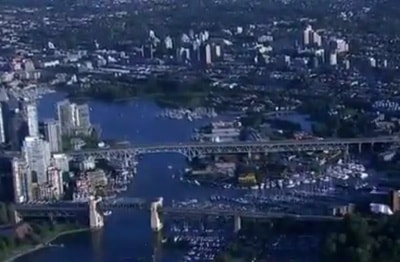Forget about parking or driving anywhere near the venues during the 2010 Winter Olympics next month.
And don't try to take your vehicle downtown.
That's the advice from organizers who today unveiled the final version of the Olympic transportation plan, which closes more roads on select high-volume days.
The Cambie Street Bridge and two blocks of Beatty Street downtown will close from noon to midnight on Feb. 10, 12 and 28 and on the Paralympic opening ceremony night of Mar. 12.
That will open pedestrian space for the estimated 100,000 spectators, visitors, media and performers expected to flood the downtown core those nights.
Feb. 10 will be a dress rehearsal and transportation dry run for the Olympic opening ceremonies two days later.
“We need every resident, commuter and employer in the Games region to pull together and adjust their transportation routines to make these Games a success,” said Terry Wright, Vanoc's executive vice-president of services and Games operations.
The temporary road closures on some of the busiest days of the Olympics are needed to ensure a positive experience for all, he said.
They come in addition to other previously announced road closures and parking restrictions in the City of Vancouver.
Olympic-only lanes for athletes, officials, media and buses, will also be designated in the curb lanes of some major corridors in Vancouver – including parts of Hastings, Cambie, Broadway and Georgia – and on approaches to the Lions Gate and Iron Workers Memorial bridges, as well as the Sea-to-Sky Highway.
A number of downtown Vancouver streets will close at noon each day starting Feb. 12 to become pedestrian corridors.
Also planned are rolling road closures as the Olympic torch relay crisscrosses the Lower Mainland from Feb. 7-11.
Motorists trying to drive to Whistler will be turned back at Alice Lake unless they have a permit proving they have somewhere to park.
Detailed maps and more information on getting around during the Olympics can be found at www.travelsmart2010.ca.
The bulk of travel to downtown is expected to be via public transit and TransLink says it will have 160 extra buses, 48 more SkyTrain cars and a third SeaBus in service to deal with an expected 30 per cent increase in demand.
Rapid transit will run at maximum frequency and for extended hours, and a network of night buses that extend service through the night after SkyTrain shuts down.
But the separate Olympic Bus Network, to carry ticket holders from Metro Vancouver to events at Cypress Mountain and Whistler, is so far undersubscribed.
Officials say about 40 per cent of the expected number of tickets have been sold.
Olympic ticket holders also have free use of regular public transit.
Between transit, walking, biking, shifting commutes to off-peak times or working from home, Vanoc and TransLink hope to achieve a 30 per cent drop in the number of normal car trips across the region.
"People have got the message and they're making their plans," said TransLink spokesman Ken Hardie.
"Alternatives like working from home – that can make a huge difference to traffic volumes in the downtown area or in those corridors where we'll have the Olympic bus lanes."
EXPANDED TRANSIT
Increased West Coast Express service runs Feb. 12-28
Night buses runs Feb. 1-28
Expo and Millennium SkyTrain lines add extra runs to 2:15 a.m. Feb. 12-28
Third SeaBus in service, providing sailings every 10 minutes Feb. 8-28
